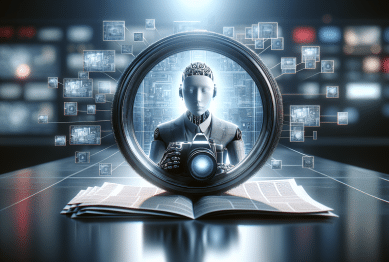Explore how artificial intelligence is transforming the news industry, reshaping reporting techniques, fact-checking, audience personalization, and even newsroom workflows. This in-depth guide highlights the evolving relationship between technology and journalism, uncovering the powerful trends shaping how stories reach you.
The Rise of Artificial Intelligence in Newsrooms
Artificial intelligence (AI) is increasingly woven into the fabric of news production. News outlets are using automated tools for content curation, breaking-news alerts, and even article generation. Major organizations rely on AI-driven applications to sort through high volumes of data, track emerging narratives, and deliver updates more rapidly than ever before. For newsrooms under pressure, this technology offers hope for handling the relentless pace and scale of modern events. With AI, information can be gathered and verified faster, reducing manual effort and allowing journalists to focus on in-depth reporting and analysis.
One of the most significant breakthroughs lies in news automation. Algorithms now scan social media, wire services, and sensor data, alerting reporters instantly when potential stories break. These signals help journalists keep up with global developments and verify facts before sharing news with audiences. Automated workflows in newsrooms are not about removing human input—they’re about empowering staff to prioritize impactful storytelling. Integrating AI can also improve how news stories are distributed, analyzed, and tailored to user interests, ensuring both speed and accuracy for readers across platforms.
Editorial decision-making is also evolving, as AI systems recommend headlines, images, or formats most likely to engage different audience segments. While ethical considerations remain, these tools are monitored and refined by newsroom professionals. The collaboration between AI engines and human editors results in higher efficiency, accurate reporting, and greater reach. Across the world, media companies are actively exploring how to balance technological benefits with journalistic integrity and transparency, highlighting a new era of news delivery shaped by innovation.
How AI Shapes News Personalization and User Experience
Personalized news feeds powered by AI are redefining how readers discover content. Algorithms analyze user behavior—clicks, shares, time spent on articles—to curate story selections tailored to unique preferences. This type of customization boosts engagement and keeps audiences returning to trusted platforms. Readers now enjoy a flow of topics aligned closely with their interests, from local politics to tech news. These advances are driven by powerful data analysis, and they mark a dramatic shift from the era of static print headlines to dynamic, tailored digital front pages.
However, there’s also debate around filter bubbles and selective exposure. When algorithms supply a constant stream of similar news, audiences might miss diverse perspectives. Researchers and technologists are working to address these concerns by developing systems that introduce topic variety while maintaining relevance. Strategies include offering recommendations from outside a user’s typical circle, spotlighting underrepresented voices, and encouraging context-driven exploration. Media outlets are increasingly transparent about their algorithms’ workings, allowing users to better understand and adjust their news consumption settings.
With AI-driven audience analytics, newsrooms also learn more about readership trends in real time. This enables editors to refine their strategies, create more responsive storytelling, and develop special content for underserved demographics. Ultimately, the marriage of technology and journalism grows stronger as both sides adapt to changing habits. AI is not only about efficiency—it’s creating richer, more engaging, and inclusive news experiences for everyone.
Tackling Misinformation: AI’s Role in Fact-Checking and Verification
Misinformation is a growing challenge for media organizations and the public. AI-powered fact-checking tools are emerging as vital allies in the fight against false narratives. These tools can scan thousands of stories, social posts, and online claims each minute, comparing them to trusted databases and known facts. Automated checks help identify inaccuracies quickly, saving human fact-checkers precious time and reducing the spread of misleading content. High-profile publishers and independent watchdogs alike turn to such systems to safeguard editorial standards and foster audience trust.
The use of natural language processing (NLP) allows AI to assess stories for bias, hyperbole, and logical consistency. These advanced programs flag suspicious claims, which are then reviewed by editorial teams. As verification processes evolve, some publishers blend AI screening with collaborative fact-checking networks, crowd-sourcing expertise from across borders. External organizations provide resources and support, further amplifying the impact of AI in upholding the credibility of newsrooms worldwide.
AI’s capacity to monitor viral content in real time is invaluable. For example, during major breaking events or elections, AI can help detect and flag unsubstantiated rumors before they go viral. This helps uphold the reliability of public information. While challenges remain—such as language nuances and contextual understanding—ongoing algorithm improvements are making automated news verification more precise and indispensable. The result is a healthier information ecosystem where truth can be separated from fiction swiftly and at scale.
Ethical and Editorial Considerations in AI-Driven News
Integrating artificial intelligence into journalism brings critical ethical questions. News professionals worry about transparency in algorithmic decisions—how stories are ranked, suggested, or even omitted by machine learning systems. Bias is another concern. If training data reflects existing prejudices, automated outputs may inadvertently reinforce them. Many newsrooms have responded by establishing oversight committees and guidelines that govern the use of AI tools within editorial processes, striving for both fairness and accountability in every stage of news delivery.
Industry organizations call for a ‘human-in-the-loop’ approach. This means editors retain ultimate decision-making authority, ensuring automated practices do not undermine journalistic integrity. Collaboration between software engineers and editorial staff is crucial; both parties invest in transparency protocols, risk analysis, and regular audits. The guiding principle is to treat AI as an assistant—not a replacement. Thoughtful implementation preserves human judgment, enables learning, and fulfills the core mission of journalism: informing and empowering the public.
Global media associations are working on best practices and ethical frameworks. These efforts emphasize openness—disclosure when AI-generated stories are published—and continual training to detect algorithmic errors. Some outlets publish guidelines for readers on how AI shapes their news, building trust through candor. As technology rapidly advances, ongoing dialogue and oversight remain essential for AI-enabled newsrooms to safeguard accuracy, reliability, and public interest across the digital landscape.
The Future of News: Collaboration Between Humans and AI
The path forward for journalism is one of co-evolution—with AI serving as a creative tool within the newsroom. Rather than replacing reporters, artificial intelligence augments their abilities and simplifies repetitive tasks. Automated content summarization, language translation, and even video editing support efficiency, freeing up time for long-form investigative reporting and audience engagement projects. This hybrid approach fosters innovation while honoring the irreplaceable perspective of experienced journalists.
Emerging AI capabilities also power new forms of storytelling. Interactive graphics, augmented reality updates, and data-driven narratives enable newsrooms to contextualize complex issues and reach global audiences. As journalism evolves, reporters will increasingly team up with technologists to experiment, iterate, and refine digital products. These partnerships help ensure the news adapts to contemporary expectations, remaining accessible and meaningful for future generations of readers.
Ongoing education is vital. Journalists are learning new skills—data analysis, ethics in automation, and cross-functional teamwork. News organizations, in turn, invest in continuous training and development. Collaboration between humans and AI means sharing responsibility for accuracy, context, and impact. This evolution leads to robust, dynamic coverage, keeping citizens informed in a rapidly shifting media environment. The boundary between technology and reporting grows less distinct, forming a new kind of journalism—agile, adaptable, and deeply connected to its audience.
What Readers Should Know About AI in News
For readers, understanding how artificial intelligence shapes news delivery is essential. AI influences what is seen, how it’s recommended, and sometimes even how it’s written. Knowledge of these workflows empowers individuals to make informed choices about media consumption. By exploring how algorithms personalize news feeds and assist with verification, readers can better distinguish between reliable reporting and manipulated narratives.
Transparency is becoming standard practice among news outlets. Many publish FAQs or documents that explain the role and limitations of AI in their editorial operations. These resources foster reader trust, clarifying how stories are selected or ranked. Emphasizing digital literacy helps audiences critically evaluate information, seek out diverse sources, and actively participate in public discourse. The interplay of technology and journalism is no longer behind the scenes—it’s part of the daily media experience.
Whether keeping up with breaking news, following local developments, or diving into investigative features, readers now interact with advanced technologies that work in tandem with human editors. Understanding the strengths and considerations of these systems is vital for active, critical engagement. As the relationship between AI and journalism evolves, ongoing dialogue between newsrooms and their audiences remains at the heart of trusted newsgathering and informed citizenry.
References
1. Newman, N., Fletcher, R., Schulz, A., et al. (2022). Reuters Institute Digital News Report. Retrieved from https://reutersinstitute.politics.ox.ac.uk/digital-news-report/2022
2. Pew Research Center. (2021). The Future of Digital Journalism. Retrieved from https://www.pewresearch.org/journalism/2021/06/22/the-future-of-digital-journalism
3. Knight Foundation. (2020). Artificial Intelligence, Journalism and Democracy. Retrieved from https://knightfoundation.org/reports/artificial-intelligence-journalism-and-democracy/
4. World Economic Forum. (2018). How AI can help journalists. Retrieved from https://www.weforum.org/agenda/2018/05/ai-journalism-news-media/
5. Reporters Without Borders. (2021). AI: A Threat or Opportunity for Journalism? Retrieved from https://rsf.org/en/ai-threat-or-opportunity-journalism
6. NiemanLab. (2022). The Ethics of AI in Newsrooms. Retrieved from https://www.niemanlab.org/2022/10/the-ethics-of-ai-in-newsrooms/









